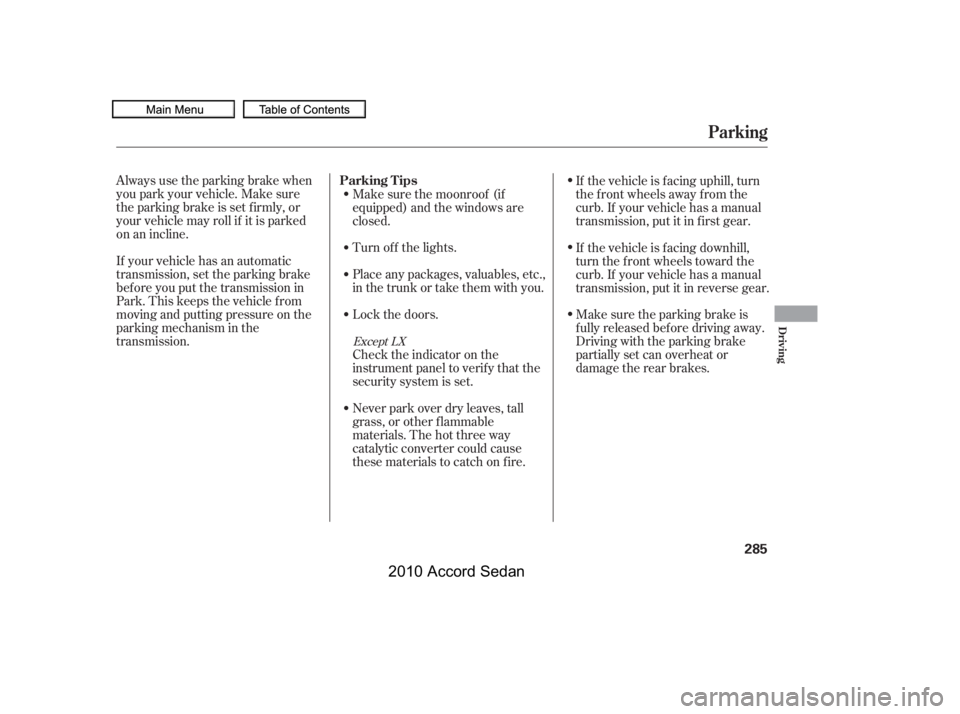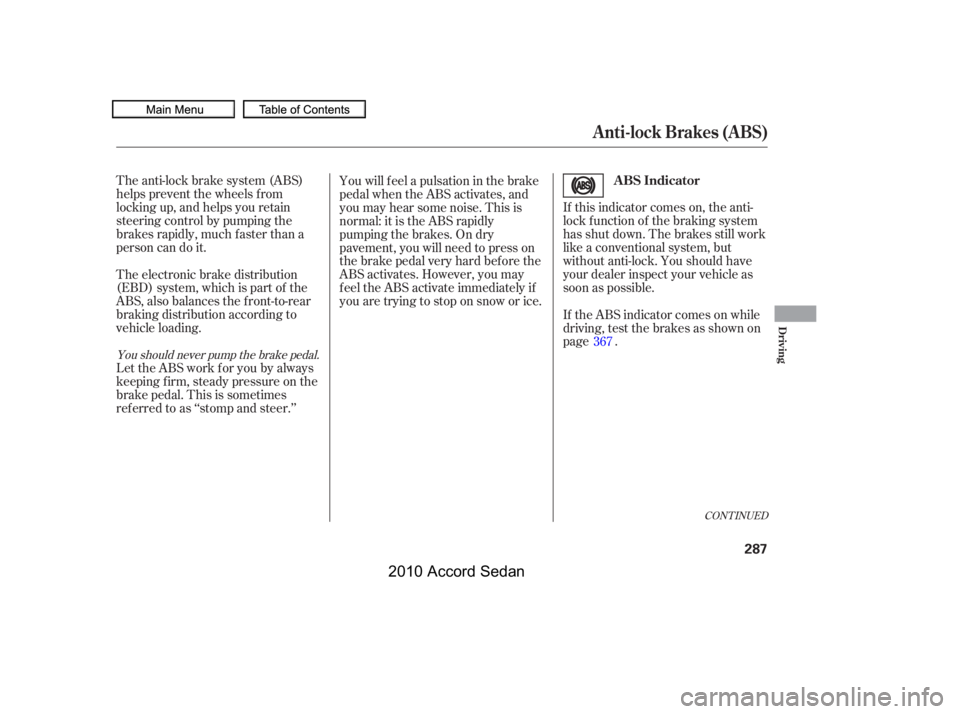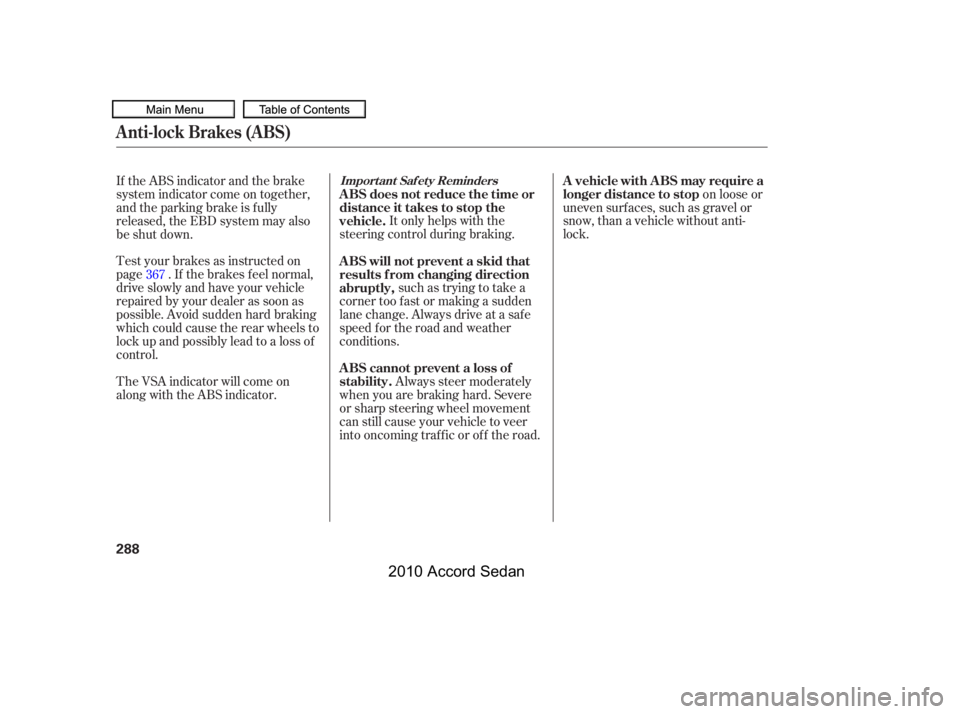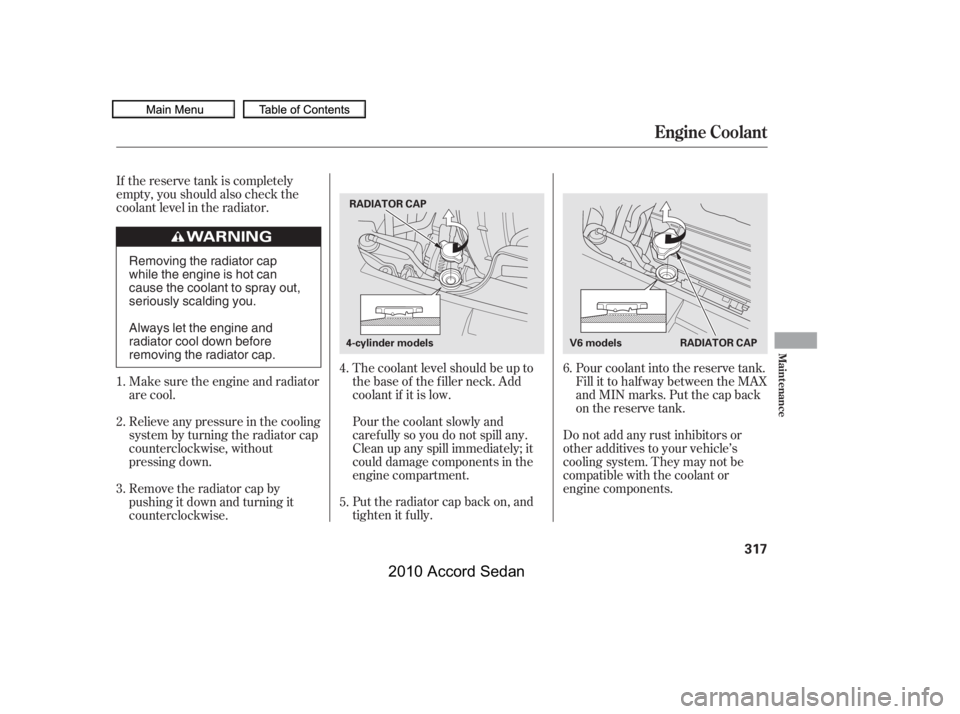Page 287 of 414
Remove the key from the shift
lock release slot, then reinstall the
cover. Make sure the notch on the
cover is on the right side. Press
the brake pedal, and restart the
engine.
If you need to use the shif t lock
release, it means your vehicle is
developing a problem. Have it
checked by your dealer.
Push down on the key while you
pressthereleasebuttononthe
f ront of the shif t lever and move
the shift lever out of Park to
neutral.
6.
5.
Automatic Transmission
284
RELEASE BUTTON
SHIFT LOCK RELEASE SLOT
�����—�����—�
���y�
���������
���y���
�)�����������y���������y
2010 Accord Sedan
Page 288 of 414

Always use the parking brake when
you park your vehicle. Make sure
the parking brake is set f irmly, or
your vehicle may roll if it is parked
on an incline.
If your vehicle has an automatic
transmission, set the parking brake
bef ore you put the transmission in
Park. This keeps the vehicle f rom
moving and putting pressure on the
parking mechanism in the
transmission.
Make sure the moonroof (if
equipped) and the windows are
closed.
Turn of f the lights.
Place any packages, valuables, etc.,
in the trunk or take them with you.
Make sure the parking brake is
f ully released bef ore driving away.
Driving with the parking brake
partially set can overheat or
damage the rear brakes.
If the vehicle is f acing uphill, turn
the front wheels away from the
curb. If your vehicle has a manual
transmission, put it in f irst gear.
If the vehicle is f acing downhill,
turn the front wheels toward the
curb. If your vehicle has a manual
transmission, put it in reverse gear.
Lock the doors.
Check the indicator on the
instrument panel to verif y that the
security system is set.
Never park over dry leaves, tall
grass, or other f lammable
materials. The hot three way
catalytic converter could cause
these materials to catch on fire.
Except LX
Parking T ips
Parking
Driving
285
�����—�����—�
���y�
�����������
�y���
�)�����������y���������y
2010 Accord Sedan
Page 289 of 414

The hydraulic system that operates
the brakes has two separate circuits.
Each circuit works diagonally across
the vehicle (the lef t-f ront brake is
connected with the right-rear brake,
etc.). If one circuit should develop a
problem, you will still have braking
at two wheels.
Your vehicle is equipped with disc
brakes at all f our wheels. A power
assist helps reduce the ef f ort needed
on the brake pedal. The emergency
brake assist system increases the
stopping f orce when you depress the
brake pedal hard in an emergency
situation. The anti-lock brake system
(ABS) helps you retain steering
control when braking very hard.
Resting your f oot on the pedal keeps
the brakes applied lightly, builds up
heat, reduces their ef f ectiveness and
reduces brake pad lif e. In addition,
f uel economy can be reduced. It also
keeps your brake lights on all the
time, conf using drivers behind you.
Check the brakes after driving
through deep water. Apply the
brakes moderately to see if they f eel
normal. If not, apply them gently and
f requently until they do. Be extra
cautious in your driving.
Constant application of the brakes
when going down a long hill builds
up heat and reduces their ef f ective-
ness. Use the engine to assist the
brakes by taking your f oot of f the
accelerator and downshif ting to a
lower gear.
The f ront and rear disc brakes on all
models have audible brake pad wear
indicators.
If the brake pads need replacing, you
will hear a distinctive, metallic
screeching sound when you apply
the brake pedal. If you do not have
the brake pads replaced, they will
screech all the time. It is normal f or
the brakes to occasionally squeal or
squeak when you apply them.
Braking System Design
Brake Pad Wear Indicators
Braking System
286
�����—�����—�
���y�
�������������y���
�)�����������y�������
�y
2010 Accord Sedan
Page 290 of 414

If this indicator comes on, the anti-
lock f unction of the braking system
has shut down. The brakes still work
like a conventional system, but
without anti-lock. You should have
your dealer inspect your vehicle as
soon as possible.
The anti-lock brake system (ABS)
helpspreventthewheelsfrom
locking up, and helps you retain
steering control by pumping the
brakes rapidly, much f aster than a
person can do it.
You will f eel a pulsation in the brake
pedal when the ABS activates, and
you may hear some noise. This is
normal: it is the ABS rapidly
pumpingthebrakes.Ondry
pavement, you will need to press on
thebrakepedalveryhardbeforethe
ABS activates. However, you may
feel the ABS activate immediately if
you are trying to stop on snow or ice.
The electronic brake distribution
(EBD) system, which is part of the
ABS, also balances the f ront-to-rear
braking distribution according to
vehicle loading.
Let the ABS work f or you by always
keeping f irm, steady pressure on the
brake pedal. This is sometimes
ref erred to as ‘‘stomp and steer.’’
If the ABS indicator comes on while
driving, test the brakes as shown on
page .367
CONT INUED
You should never pump the brake pedal.
ABS Indicator
Anti-lock Brakes (ABS)
Driving
287
�����—�����—�
���y�
�������������y���
�)�����������y���������y
2010 Accord Sedan
Page 291 of 414

It only helps with the
steering control during braking.
such as trying to take a
corner too f ast or making a sudden
lane change. Always drive at a safe
speed f or the road and weather
conditions.
Always steer moderately
when you are braking hard. Severe
or sharp steering wheel movement
can still cause your vehicle to veer
into oncoming traffic or off the road.
on loose or
uneven surf aces, such as gravel or
snow, than a vehicle without anti-
lock.
Test your brakes as instructed on
page . If the brakes f eel normal,
drive slowly and have your vehicle
repaired by your dealer as soon as
possible. Avoid sudden hard braking
which could cause the rear wheels to
lock up and possibly lead to a loss of
control.
If the ABS indicator and the brake
system indicator come on together,
and the parking brake is f ully
released, the EBD system may also
be shut down.
The VSA indicator will come on
alongwiththeABSindicator.
367
A BS does not reduce the time or
distance it takes to stop the
vehicle.
A BS will not prevent a skid that
results f rom changing direction
abruptly,
A BS cannot prevent a loss of
stability.
A vehicle with A BS may require a
longer distance to stop
Import ant Saf et y Reminders
Anti-lock Brakes (ABS)
288
�����—�����—�
���y�
�������������y���
�)�����������y���������y
2010 Accord Sedan
Page 320 of 414

The coolant level should be up to
the base of the f iller neck. Add
coolant if it is low.
Pourthecoolantslowlyand
caref ully so you do not spill any.
Clean up any spill immediately; it
could damage components in the
engine compartment.
Put the radiator cap back on, and
tighten it fully.
Pour coolant into the reserve tank.
Fill it to half way between the MAX
and MIN marks. Put the cap back
on the reserve tank.
Do not add any rust inhibitors or
other additives to your vehicle’s
cooling system. They may not be
compatible with the coolant or
engine components.
If the reserve tank is completely
empty, you should also check the
coolant level in the radiator.
Remove the radiator cap by
pushingitdownandturningit
counterclockwise.
Relieve any pressure in the cooling
system by turning the radiator cap
counterclockwise, without
pressing down.
Make sure the engine and radiator
are cool.
4.
1.
2.
3.
5.
6.
Engine Coolant
Maint enance
317
RADIATOR CAP
RADIATOR CAP
V6 models4-cylinder models
Removing the radiator cap
while the engine is hot can
cause the coolant to spray out,
seriously scalding you.
Always let the engine and
radiator cool down before
removing the radiator cap.
09/07/08 21:41:58 31TA5620_322
2010 Accord Sedan
Page 327 of 414

�µ�µ
The timing belt should be replaced
according to the maintenance
minder (see page ).
Replace the timing belt every 60,000
miles (U.S.) or every 100,000 km
(Canada) if you regularly drive your
vehicle in any of the f ollowing
conditions:
Always use Honda Power Steering
Fluid. You may use another power
steering f luid as an emergency
replacement, but have the power
steering system f lushed and ref illed
with Honda PSF as soon as possible.
A low power steering f luid level can
indicate a leak in the system. Check
the f luid level f requently, and have
the system inspected as soon as
possible.
In very high temperatures
(over 110°F, 43°C).
In very low temperatures
(under 20°F, 29°C).
Pour the f luid slowly and caref ully
so you do not spill any. Clean up
any spills immediately; it could
damage components in the engine
compartment.
If you f requently tow a trailer.
303
V6 models
Timing Belt
Power Steering Fluid, Timing Belt
324
UPPER LEVEL
LOWER LEVELV6 models
Turning the steering wheel to f ull lef t
or right lock and holding it there can
damage the power steering pump.
�����—�����—�
���y�
���������
���y���
�)�����������y���������y
2010 Accord Sedan
Page 329 of 414
Remove the electrical connector
f rom the bulb by pushing on the
tab to unlock it, then slide the
connector of f the bulb.
Remove the bulb by turning it
approximately one-quarter turn
counterclockwise.
To change a bulb on the driver’s side,
undo the f astener and remove the air
intake cover and duct.
3.
2.V6 models
Lights
326
FASTENERAIR INTAKE COVERBULB
V6 modelsSTAYV6 modelsTABDUCT
�����—�����—�
���y�
�������������y���
�)�����������y�������
�y
2010 Accord Sedan